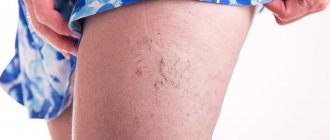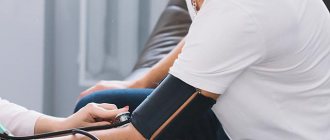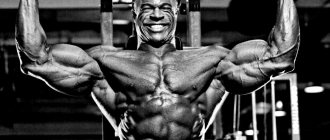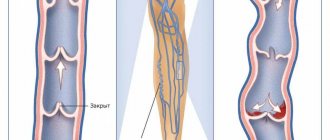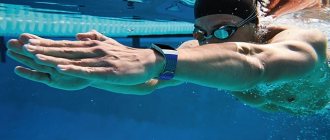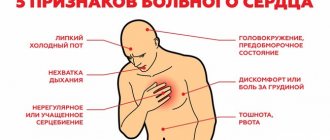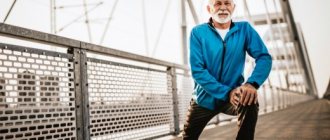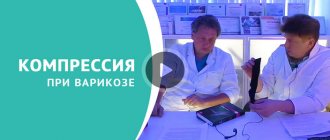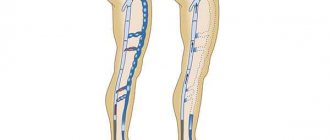The road to beauty and youth is long and difficult. However, sometimes on the path to perfection such an unpleasant problem as varicose veins arises. Unfortunately, this disease appears not only in women who have experienced the joy of motherhood and the elderly, but also in young people. Statistics show that more than 60% of the fair sex and about 10% of men are predisposed to varicose veins.
Everyone knows perfectly well that running normalizes weight and improves lung ventilation, trains the heart and increases vitality. But is running with varicose veins acceptable? How will dilated veins respond to physical activity? The issue requires detailed consideration.
Mechanism of the disease
Blood circulation throughout the human body is continuous. It flows down to the legs and, under the influence of residual blood pressure, returns upward. If the leg muscles contract, blood is forced back toward the heart.
In some cases, a malfunction occurs in the functioning of the body, the cause of which is most often the person himself.
Don't put it off until tomorrow, START running today!
Running group “START” - from 0 to 5 km. per monthMore details
Reluctance to give the muscles the appropriate load leads to the occurrence or worsening of varicose veins. As a result, blood circulation in the legs is disrupted, congestion appears in the form of heaviness, swelling in the evenings and night cramps.
If you do not pay attention to these sensations, the disease will progress. At the same time, spider veins will become more distinct and brighter, the veins in the legs will begin to swell and protrude to the surface. Running can help in the fight against varicose veins in the early stages.
Recommendations
Do not despair if varicose veins are diagnosed. A phlebologist will tell you which sport to choose. Illness is not a death sentence. The main thing is that the chosen sports for varicose veins do not overload the blood vessels, avoid heavy weights and shock loads on the legs.
In addition, you need to monitor your health by adjusting your diet and choosing the right regimen. It is necessary to exclude spicy and fatty foods from the menu, reduce the consumption of carbohydrates and animal fats. Alcohol and smoking should be completely avoided.
You cannot wear tight shoes. This will lead to poor circulation and the risk of blood clot formation.
You can reduce the load on your legs by losing excess weight. Therefore, moderate exercise for varicose veins and maintaining physical activity will be very useful.
The benefits of running for varicose veins
Dynamic loads at a moderate pace will bring undoubted benefits, ensuring good blood flow. This occurs due to the muscle groups of the legs, thighs, and feet. Well-trained muscles enable the muscular-venous pump to work uninterruptedly. If the valves work correctly and without disturbances, then slight physical activity will be beneficial for the muscles. Otherwise, training should be taken with caution.
When the disease is at an early stage, light jogging is not contraindicated. You can accurately determine whether exercise is permissible using duplex scanning of veins. It will accurately show whether there is reflux - the reverse movement of blood through the veins due to impaired functioning of the valves. If reflux is not detected, then you can run. In this case, the following conditions must be taken into account:
- You should not try to set a world record for speed and distance. A moderate to slow pace and short distances will provide noticeable benefits. Running with acceleration is a power load and is contraindicated for varicose veins.
- Sports running shoes must be purchased in specialized stores, taking into account all the individual characteristics of the foot. It must have special insoles.
- When jogging, you should always wear compression stockings or socks that have the appropriate certification. Your doctor will help determine the level of compression.
- Initial classes should not last more than 15-30 minutes.
Healthy foods
The basis of the optimal diet for a patient with varicose veins is:
- lean sea fish;
- tomatoes;
- dried fruits;
- carrot;
- nuts (except walnuts);
- onion;
- cranberry;
- garlic;
- currant;
- citrus;
- cherries;
- kiwi;
- blueberry;
- cereals (buckwheat is especially useful);
- pears;
- grape;
- sea buckthorn;
- whole wheat bread;
- watermelons;
- low-fat fermented milk products;
- eggplant;
- seafood;
- pumpkin;
- seaweed;
- melon;
- unsalted cheese.
Consumption of animal fats should be kept to a minimum. Dishes should be flavored with a small amount of vegetable oil.
You need to eat meat, but little by little (2-3 times a week is enough). Preference should be given to beef, chicken, turkey, veal, and rabbit.
What are compression socks for running and how do they work?
The function of compression socks for running is to improve blood flow in the veins.
Thanks to the effects of golf, the diameter of the veins decreases and the functioning of the venous valves is restored. Blood circulates better through the veins and is better saturated with oxygen. Thus, toxins are eliminated from the body faster and the amount of energy increases. For an athlete, the correct functioning of the circulatory system is important, because this increases the endurance and performance of the entire body.
Golfs have additional benefits. They create a “frame” for the leg and support the calf muscles. As a result, muscle vibrations are reduced and the risk of injury is reduced. In compression socks, spasms, cramps and swelling occur less. These socks are not hot, they do not slip or curl. Silver ions in fabric threads create an antimicrobial effect and prevent unpleasant odors. For greater comfort, choose seamless products that prevent skin chafing.
| Women's compression socks 2XU WA1994e | Men's compression socks 2XU MA1993e | Compression socks CEP men's thin C1UM |
General principles of nutrition
When following a diet for blood vessels, it is important not only to choose healthy foods wisely, but also to adhere to the rules of nutrition:
- be sure to have breakfast. At this meal you need to eat about half the daily amount of carbohydrates and proteins;
- eat 5-6 times a day in small portions. This mode will evenly distribute the load on the digestive tract and valve-pump system;
- do not drink food, so as not to reduce the concentration of gastric juice;
- Organize your last meal 3-4 hours before bedtime.
Particular attention should be paid to giving up bad habits - smoking, alcohol abuse. They increase blood clotting and slow down metabolism. You should also not take any pharmaceutical drugs without a doctor's prescription.
Three rules for maintaining the effectiveness of compression golf
First rule. Hand wash only. Wash your socks after each use in warm water and liquid soap. During wear, the fabric stretches, and water restores the compression properties of the product.
Second rule. Do not twist your knee socks after washing. With strong twisting, the special knitting of the fabric, which creates compression, deteriorates.
Third rule. Socks should be dried flat, away from heating appliances. This helps preserve the fabric in its original condition.
High-quality compression socks for running preserve the beauty of your legs and protect the body from varicose veins, swelling, pain and the risk of blood clots.
Salons and the online store offer a wide range of compression socks for running and a competent approach to their individual selection.
The only treatment is surgery: is it possible to do without incisions?
Varicose veins are a disease that can only be treated radically - surgically. There are many types of operations: using a laser (sealing veins), sclerotherapy (a special drug is injected into the vein, as a result it “sticks together”), phlebectomy (classic operation - removal of veins from incisions), miniphlebectomy (removal without incisions, through punctures - minimally invasive method).
Traditionally, these operations are performed under local anesthesia. As a rule, they are so minimally invasive that you can get up and walk immediately after returning from the operating room. This is done to prevent a rare but dangerous complication - deep vein thrombosis. If the patient wishes or is afraid, it is permissible to use general anesthesia for a short period of time. On average, the operation lasts half an hour. After the intervention, there are no stitches left (except for a variant of the classical operation, which is now practically not used) - only temporary bruises.
Modern treatment methods allow you to start training at any intensity already 3-4 days after surgery. And already a month after the operation, you can again engage in those sports that are not recommended for varicose veins - for example, lifting weights.
There is an opinion that after surgery and sealing of some veins, over time the neighboring ones will inevitably begin to expand. However, the average relapse rate is 15%. That is, only 15% of those operated on will experience a relapse during the rest of their lives. Therefore, all patients with varicose veins, even after surgery, are recommended to visit a phlebologist once a year.
Complications of the disease
If varicose veins of the lower extremities progress, then a person develops symptoms such as:
- leg pain;
- cramps at night;
- even more severe swelling;
- bulging veins.
If the disease has progressed to these stages, then running loads can worsen the condition of blood vessels and, as a result, the well-being of the person himself. You need to understand that when running, a strong blood flow is created, which weak blood vessels may not be able to cope with.
If thrombophlebitis is diagnosed, then you can no longer run, since increased blood flow can cause a blood clot to break off, which often leads to death.
Forbidden food
It is advisable for a person with varicose veins to completely avoid foods such as:
- baked goods;
- salo;
- spicy seasonings;
- walnuts;
- candies;
- cakes, pastries;
- sausages;
- meat and fish of fatty varieties;
- preserves, jams;
- pickles;
- chocolate;
- condensed milk;
- smoked meats;
- ice cream;
- semi-finished products;
- marinades;
- butter;
- bananas;
- canned meat and fish;
- rich broths (including jellied meats, jellies, etc.);
- legumes
Attention: it is necessary to reduce the consumption of foods rich in vitamin K. This substance increases blood clotting, and in large quantities can provoke thrombosis.
“Finding” vitamin K is easy. All green vegetables, as well as herbs and leafy salads, are rich in it. There are many compounds in walnuts, liver, eggs, red meat, and whole milk.
The body needs salt, but in small quantities (about 3-5 g per day). Its excess retains moisture and contributes to the development of swelling.
What are varicose veins
leg exercises for veins Varicose veins are a pathology of the vessels of the lower extremities, which reduces the tone and elasticity of the veins. The process leads to the formation of nodes due to excessive stretching of the walls of blood vessels.
The disease can be caused by the following factors:
- Prolonged stay in a sitting or immobilized state.
- Hereditary predisposition to the development of varicose veins.
- Excess body weight.
- Changes in hormonal levels. Most often, the disease affects women who are in a state of menopause or pregnancy, after childbirth.
- Age over 50 years.
- Injuries of the lower extremities.
- The formation of nodes and excessively enlarged veins occurs due to frequent standing for long periods of time. This leads to stagnation of blood in the veins.
Great exercises for varicose veins
The main goal of sports and fitness for varicose veins is to reduce blood stagnation in the veins and to apply measured stress on the legs. For a complete training program, in addition to strength exercises, you will need cardio.
The following types of exercises are suitable for varicose veins:
- Calf raises in a sitting or standing position with dumbbells.
- Performing the “bicycle” exercise in a lying position.
- Leg raises while lying on your back.
- Standing on your knees, lean forward on your hands and swing your legs back.
- In a sitting position, bend and straighten your shins.
- Stepping onto a bench with dumbbells in your hands.
- Lunges with dumbbells to the sides.
- For cardio training, swimming in the pool in the crawl style, moderate walking on a treadmill for 15-20 minutes, and exercise on an exercise bike are ideal.{banner_st-d-2}
What cannot cure varicose veins: pills, creams and stockings
To alleviate the negative symptoms of varicose veins, compression hosiery is used: these are socks, stockings or tights that create pressure on the legs to improve blood flow. Knitwear is used more often for static positions (if you need to sit in an office, stand at a counter or behind a pulpit), and during sports, blood flow improves due to movement, so you can exercise without compression garments.
Most often, advertisements offer creams as a treatment for varicose veins. They won't help. The cause of varicose veins is not clear, and there is not a single drug with a proven effect - preventive or therapeutic. Therefore, none of the creams that are sold “for varicose veins” have proven effectiveness.
Venotonics/phlebotonics tablets will also not help “remove” varicose veins and will not make the veins that bulge out due to varicose veins disappear. All phlebotonics, when used for varicose veins, are exclusively symptomatic drugs; they alleviate or remove symptoms, but do not improve or prevent anything. Phlebotonics are also indicated if there is no varicose veins, but there is heaviness and swelling in the legs. If you have varicose veins, but you don’t want to have surgery, phlebotonics are also indicated to relieve symptoms.
Which exercise machine is better for combating varicose veins?
One of the most popular options actively used to combat vascular diseases of the legs in the initial stage is exercise equipment. It is important to choose the right simulator here. If training is needed to prevent the development of a disease, then any model will do. Otherwise, you should give preference to an exercise bike with a horizontal seat, for example, BRONZE GYM R801 LC.
But treadmills are a much more difficult option if symptoms of the disease are already present.
In this case, under no circumstances should you carry out long runs at high speeds. Only light workouts with periodic transitions to a walking step. And the duration of the workout itself should not exceed twenty minutes. Also, before starting training, you should be concerned about finding special orthopedic running shoes that will reduce the level of stress.
First symptoms
What characterizes the onset of varicose veins of the lower extremities:
- the appearance of spider veins;
- swelling of the legs, especially in the evening, which disappears by morning;
- burning sensation in the legs;
- feeling of fullness in the calves.
If such symptoms are present, then before you start exercising, you need to undergo a vascular examination and consult a phlebologist.
So is it possible to run with varicose veins? Light jogging will not only do no harm, but will also be beneficial, as it will help keep your leg muscles toned. You need to do physical exercise in a way that is safe and beneficial for the body.
